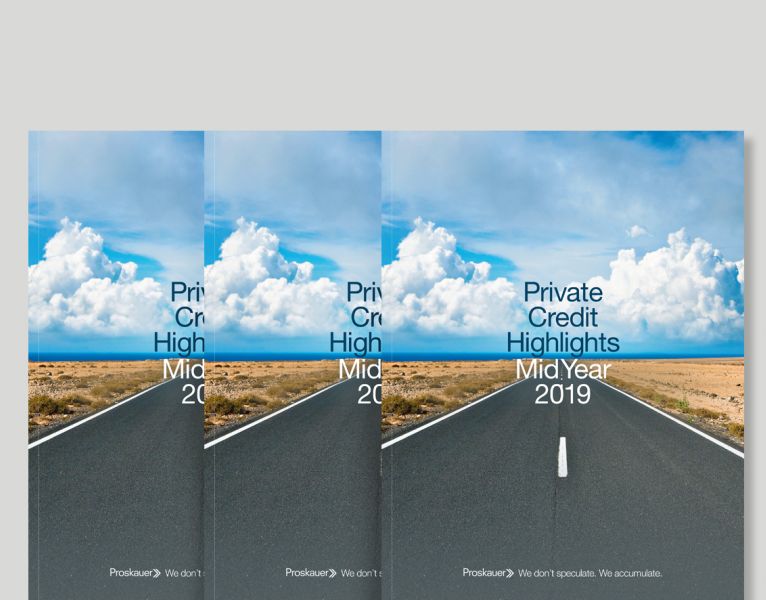A global economic slowdown, trade troubles, particularly with China, global political volatility and other economic factors are fueling concern about economic headwinds. While the likelihood of a recession is far from certain, any prudent asset manager has to weigh the risks and prepare for the possibility of some level of negative activity in 2020 and 2021. Here are eight practical tips on how private credit lenders are (or should be) preparing.
1. Know the Loan Documents.
It is well known that credit documentation has become more flexible. In the traditional leverage finance area, there has been a general shift towards capital market or broadly syndicated market terms in private credit transactions. Based upon Proskauer’s mid-year data report, for instance, 72% of deals are cov-lite or cov-loose. Even those with covenants have a 39.5% set back to closing leverage. EBITDA add-backs are increasingly common, with generous caps, if any, on run rate synergies and the like.
Overall, these provisions (and others) provide borrowers with more flexibility to re-lever the business, engage in a broad range of asset disposition and investment activities without lender involvement, realize a return on their capital while maintaining control, and manage their lender group during good and bad times. We have already seen some of these provisions used in ways not intended.
There are less discussed documentation provisions that could also yield surprising results for lenders as a borrower starts to go sideways. To list a few:
- Voting provisions have emboldened the rights of majority lenders. So-called “sacred rights” provisions (amendments that require the consent of “all lenders” or “lenders affected thereby”) may exclude key protections against changes to the waterfall or pro rata sharing provisions. Limited sacred right protections make it easier for borrowers, together with the support of required lenders, to effectuate a restructuring (including creating senior, priming tranches of debt). Couple this flexibility with debt incurrence, refinancings, amend-and-extend and other provisions, and minority lenders could find that they are left with a silent stub instrument and effectively dragged along in a restructuring.
- The ability of lenders to impose the default rate of interest is often limited only to instances of payment default and bankruptcy, and even then, often only imposed on overdue amounts. Imposition of default interest was a means of “getting the borrower to the table” and to initiate a discussion. The typical construct for default interest today may delay that discussion.
- Loan documents often do not require the borrower to provide control agreements over accounts. Even if delivery of control agreements is required, many types of deposit accounts are often exempted from this requirement (e.g. foreign accounts). The lack of control agreements means the lender does not have (in most instances) a perfected security interest in cash. The absence of the ability to spring cash control limits the leverage of lenders and may allow the borrower to build a “war chest” to finance an in-court restructuring without the need for a DIP loan or to seek lender’s consent to use cash.
- Loan documentation may make it difficult for a lender to exit a troubled credit. Loan documentation often provides that lenders can only assign their debt absent the consent of the borrower, which is often required unless there is a payment or insolvency event of default. Even when the borrower’s consent is not required, the expansion of “blacklists” and general prohibitions on assigning to competitors makes it increasingly difficult for lenders to exit troubled credits without going through the borrower.
In a robust economic cycle, risks inherent in more flexible loan documentation may be masked because a lender may be able to “kick the can down the road”, trade out of their position or exit through a sale or refinancing. In these less certain times, however, these options may not be readily available (or desirable). Thoroughly understanding the traps, holes and pitfalls will be key to knowing where the risks and opportunities lie.
2. Track Basket Usage.
All of these loan documentation provisions interact in a complex fashion particularly as it pertains to covenant baskets. Private credit lenders should track debt incurrence (and layering capacity), investment capability, available amount capacity, and other basket usage especially as a company begins to underperform.
Tracking usage, however, is not easy. The borrower may not have (and may not be obligated to) report basket usage and availability (and asking a distressed borrower may highlight the issue). Even if a basket has been used, it may be subject to builder components and reclassification. For instance, the credit agreement may permit the reclassification of certain debt incurrences (often automatically) from a “freebie” or non-leverage based component to a leverage-based component thereby reloading the “freebie” component. Making it more complicated, the sponsor may have the ability to reclassify available amount capacity to other baskets like debt or investments.
Even if difficult, private credit lenders should anticipate that borrowers will take advantage of the negotiated flexibility afforded by these baskets.
3. Monitor, Monitor, Monitor.
Sometimes the simplest thing is the most effective. Under today’s loan documentation, lenders may not have the benefit of financial covenants, which if breached, provide an early warning sign of deterioration of a borrower. In the absence of financial covenants (or meaningful covenants), the lender must more closely monitor the portfolio company – review the monthly, quarterly or available other financial information. Tracking and benchmarking performance is essential to highlighting portfolio companies that may be at risk.
Monitoring does not stop at the reporting stage. Most private credit lenders have relationships with their sponsors. The strength of those relationships will be tested in a downside scenario. However, leaning in on those for information early and maintaining steady and constant communication facilitates resolution and helps avoid conflict.
An underutilized resource for information is management itself. Get to know management. Speaking with management directly will provide further insights into the performance of the business, industry insights and early indications of issues. The lender can also use these interactions to assess management and form a relationship that may be valuable down the line.
Finally, research industry information, talk to trading desks to get the “word on the street”, tap into industry experts, and talk to advisors to stay on top of latest developments. All of this information leads to a more complete picture and perhaps helps to start discussions with the borrower, sponsor or other lender constituents even in the absence of a default.
4. Conduct a “360” Review.
Know what revolves around your credit. What is the capital structure? Often overlooked are liabilities such as capital leases, litigation claims and other off-balance sheet liabilities. Review the corporate structure and how it intersects with the loan structure (and make sure you have a current structure chart). Which entities are loan parties and which are outside the loan party group (i.e. unrestricted subsidiaries, less than wholly-owned subsidiaries, joint ventures, foreign subsidiaries)? These factors will play heavily in a restructuring. Finally, do not overlook who the players are and who they have as their advisors and counsel. The company they keep will tell you a lot as to how they are going to act.
5. Conduct a Perfection Review.
“All” does not mean all. There has been a steady expansion of what is excluded from the “all asset” lien. The list of excluded assets now covers a page or more! Assets excluded from the all asset lien now cover far more than the difficult to perfect or de minimus assets. Instead, it now includes entire categories of assets, such as cash, real estate, other assets that the borrower (or agent) may determine that the cost is not worth going through the effort to perfect, any foreign assets, assets the perfection of security interests in which may not then be permitted or cause adverse tax consequences, and the list goes on. The more limited collateral packages could have practical implications in terms of how a stressed borrower might leverage those assets (with structurally senior financing), complicate collateral valuation issues, or otherwise constrain the ability of the lender to realize upon the borrower as a going concern.
6. Every Ask Should be Accompanied by a Give.
To paraphrase the Beatles: in the end, how much a sponsor gets should be equal to what it gives.[1] When a company starts to go sideways, start to anticipate the “asks” and thinking about the “gives”. The loan documentation may constrain a lender from getting to the table, but the economic realities may require the borrower to invite its lenders to talk. That is a good time to plug holes (which starts with knowing the credit documents) and establish milestones for results.
7. Hire Experienced Restructuring Experts.
It has been over a decade since the last down cycle. As a result, there is an experience gap on all sides of the table. Workouts are incredibly time-consuming. Building up the internal capabilities is not only a practical solution but a key risk management tool. Equally important is developing external relationships with the right people. Members of our multi-disciplinary team have practiced on both the transactions and restructurings for alternative lenders for over 25 years. There is no question that developing the necessary skill takes time and actual experience. For direct lenders, who have flexible capital and can act opportunistically, having restructuring advisors who understand the private credit model, are familiar with their fund structures and other unique considerations, and are experienced in restructurings for alternative lenders will be crucial to managing risk and being in a position to take advantage of opportunities.
8. Look for the Opportunities.
The tips above are what any prudent private credit asset manager should do to protect their portfolio of credit investments. However, following these tips may also help uncover and position the investor to take advantage of rescue financing, special situations, structured equity, and other lucrative opportunities that will arise.
Most private credit lenders are anticipating some level of increased restructuring activity. These suggestions reflect what they are doing and how other private credit lenders can prepare.
[1] “The End” song by the Beatles: “And in the end, the love you get is equal to the love you give.”




